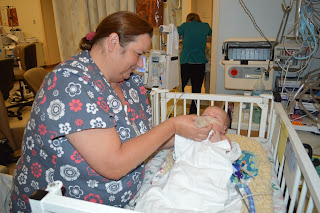Everything had been normal during Jill’s pregnancy, and we were expecting a routine delivery. We went to the hospital around
A couple of minutes after Dr. Riley left, Hayes’ heart rate
plummeted. Our nurse adjusted some of
the monitoring equipment to see if that was the problem. When she couldn’t find a stronger heartbeat,
she told Jill that she had to start pushing right away. The nurse also called a “code pink.” Within a couple of minutes, there were at
least a dozen nurses and doctors in our room.
Since this was our fourth child, we knew all of these people in our room
was not a good sign. I googled “code
pink” later and learned that while it can mean different things at different
hospitals, one of its meanings is “activation of the response team for a fetus,
newly born infant or neonate at risk for/in cardiorespiratory arrest.”
Within 10 or 15 minutes from when his heart rate first
dropped, Hayes was born. His umbilical
cord was wrapped tightly around his neck, he wasn’t breathing, and his heartrate was still dangerously low. We would later find out that he had lost
nearly half his blood during the delivery.
The doctors still aren’t sure exactly what happened. The working theory is that the placenta
detached prematurely, causing him to lose so much blood.
Dr. Riley handed Hayes to Jill while he suctioned out his
nose and mouth. Hayes didn’t take a
breath. He then handed Hayes off to the
infant life support team, which were some of the people who had come into our
room when our nurse called a code pink.
The life support team immediately began performing cpr. They pushed on his tiny chest with one
finger. Then they gave him a couple of
breaths through a small, balloon-like contraption that was attached to a
tube. They’d put the tube in his mouth
and then squeeze the ball. Jill and I
were in a state of shock at this point.
And of course, we couldn’t ask anyone what was going on, since
they were all trying to keep our baby alive.
Watching the life support team huddled around our tiny baby, desperately
working to keep him alive, was easily the most terrifying 15 minutes of either
Jill’s or my life.
Dr. Riley tried to sooth us, telling us that we’d hear him cry
any second. We waited. We didn’t hear him cry. Finally, after what seemed like an eternity,
but was actually only about 15 or 20 minutes, they got his heart rate up. Hayes was still having trouble breathing, so
they intubated him. Then they immediately
moved him to the NICU.
Hayes had to stay on the blanket for 72 hours. After that, they would slowly warm him.
He was freezing and was miserable. The doctors had to keep him doped up on morphine to keep him comfortable and calm. If he got too fussy, it would raise his body temperature, which they did not want.
But he was a feisty little guy. One of the nurses put some socks on his hands to keep him from yanking the tube out of his nose.
While they were cooling him, they also monitored him for seizures. He was hooked up to an EEG machine, and a technician monitored the readins 24 hours a day remotely. There was a video camera connected to the EEG, so they could see him as well.
We brought the girls down to see him on the second day. Brooke thought it was all very exciting.
Ash wasn't quite sure what to think about it.
And poor Sadie was somewhat traumatized. She woke up the next morning complaining that she was having a hard time breathing. She had a miraculous recovery when I told her she'd have to stay in bed all day and rest.
This is how we spent most of Hayes' first 72 hours. Sitting by his cooling pad in the NICU.
The first 72 hours went by without any seizures, which was a very positive sign. Here, they have finally taken him off the cooling pad and are slowly warming him up.
Poor guy got poked a lot. You can see some bruising from where they tried to get a line in.
He was still a little groggy. It took all of the morphine a couple of days to work its way out of his system.
Once he was warmed up, we finally got to hold Hayes for the first time - more than three days after he was born. That was a happy day.
After he was warmed up, Hayes was sent to get an MRI. The doctors said the MRI was normal. They couldn't see any evidence of long-term brain damage! We were beyond relieved.
This is my beyond-relieved face.
Hayes was relieved too.
This is our nurse Stefania giving Hayes his first bottle. All of the doctors and nurses in the NICU were great, but Stefania was amazing. She really took great care of our Hayes.
Hayes couldn't quite figure out how this complicated bottle contraption worked at first. He's definitely figured it out now.
Our nurse kept telling us Hayes would probably be in the NICU at least 10 days. But when Jill went in on Tuesday the 23rd, one week after Hayes was born, the nurse said the doctor and just been by and would be discharging Hayes that day. Hayes was so happy. I think he might have cracked a smile.
I just like this picture.
Jill taking the handoff from the nurse.
Hayes all buckled up and ready to roll.
The girls are very excited to have him home. They have all been great with Hayes.
Ann was, as she so often is for us, a life-saver while Hayes was in the NICU. We knew we didn't have to worry about our girls. They were in good hands.


































No comments:
Post a Comment